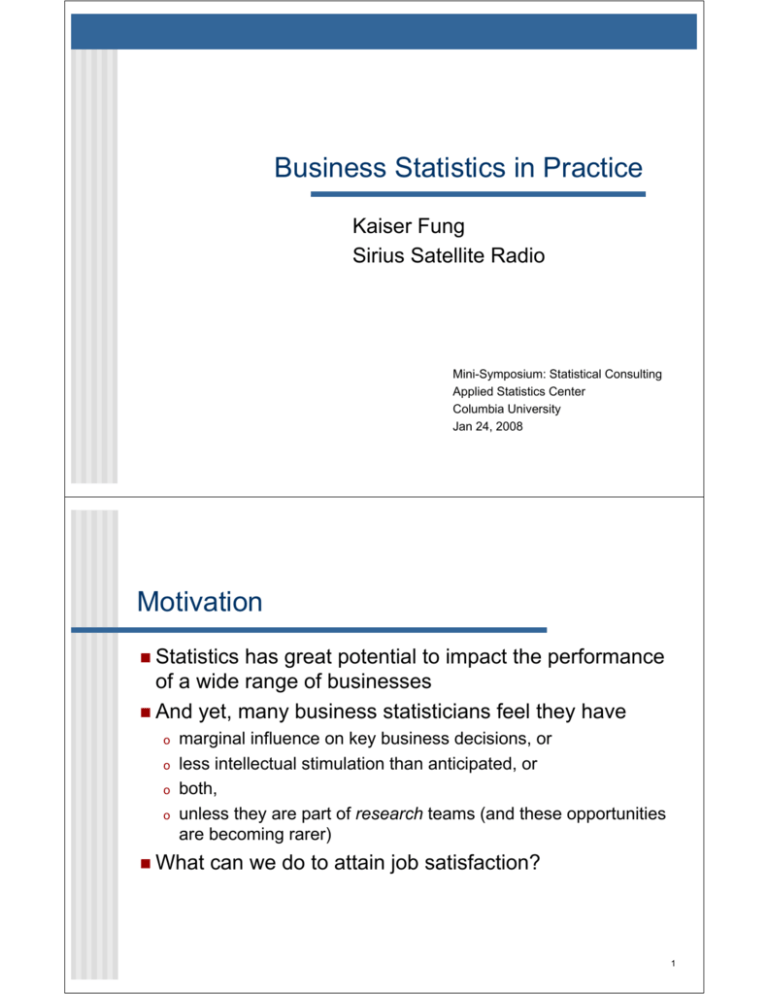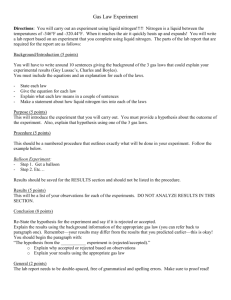Business Statistics in Practice Motivation
advertisement

Business Statistics in Practice Kaiser Fung Sirius Satellite Radio Mini-Symposium: Statistical Consulting Applied Statistics Center Columbia University Jan 24, 2008 Motivation Statistics has great potential to impact the performance of a wide range of businesses And yet, many business statisticians feel they have o o o o marginal influence on key business decisions, or less intellectual stimulation than anticipated, or both, unless they are part of research teams (and these opportunities are becoming rarer) What can we do to attain job satisfaction? 1 Synopsis Some typical business statistics problems Thinking like a business person Presenting analysis o Presenting data o Knowing the business Knowing the business, really o Recognising human psychology o Seeking intellectual stimulation 2 Business statistics problems Credit scoring models Risk management models Customer profiling and segmentation Predictive response models Marketing / industrial experiments Quality control, Six Sigma Survey research analysis Conjoint models Choice models 3 Thinking like a business person Presenting o o o o Focus on key takeaways, not process Reverse scientific deduction Eradicate jargon Be parsimonius Presenting o o analysis data Use graphics Use annotations 4 Presenting analysis like a scientist Business problem: Why do some customers leave the franchise? Analysis: Elimination of hypotheses Hypothesis A: Hypothesis B: Hypothesis C: Hypothesis D: Hypothesis E: Lost to competitor Lost to ipods Lost to internet Faulty radios Service incident Rejected Rejected Rejected Rejected Plausible: further analysis to confirm Scientific argument 5 Presenting analysis for a business audience Hypothesis A: Hypothesis B: Hypothesis C: Hypothesis D: Hypothesis E: Lost to competitor Lost to ipods Lost to internet Faulty radios Service incident Rejected Rejected Rejected Rejected Plausible: further analysis to confirm Business case 6 Presenting data in science Scientific journal Coefficient Standard Error Constant Pairwise comparisons Primary concerns o o o P-values Two-tailed Star system Comprehensive Precise Technical R-sq, adj N Kastellec & Leoni (2007) 7 Presenting data in business Business case Country effects are relatively strong All other effects are relatively weak Graph it Annotate it Draw attention to key message Get to the point Eradicate jargon Correlated with higher aggression Adapted from Kastellec & Leoni (2007) 8 Knowing the business Crucial o o o to understand the business context Finance: How does a company make money? Psychology: How are decisions made? What incentives motivate the work force? Marketing: What is the customer life cycle? What affects customer behavior? How to pick up the knowledge? o o o o o Nothing beats on-the-ground experience Business news and magazines (Wall Street Journal, Financial Times, Economist, Business Week, Fortune, Forbes, CNBC, etc.) MBA courses Business books Unconventional: Dilbert, The Office, etc. 9 Recognising human psychology Trust intuition (experience) should data or logic fails to “make sense” Biased sample Inconclusive or negative results are a waste of time When in doubt, search harder Publication bias Multiple comparisons 10 Intellectual stimulation If managed well, employees will have opportunity to pursue intellectually challenging projects Plenty of unsolved business problems Reject inference o Missing data problems o Rare event prediction o Observational data o etc. o Business impact is a bonus, not a given 11 Reading Tufte, Wainer, Gelman, Junk Charts Kahneman, Tversky and associates Davenport & Harris: Competing on Analytics Ayres, Supercrunchers Lewis, Moneyball Heath & Heath: Made to Stick Fisher and Ury: Getting to Yes Higgins: Analysis for Financial Management Taleb, Fooled by Randomness or The Black Swan 12









